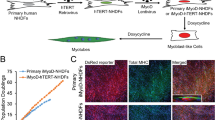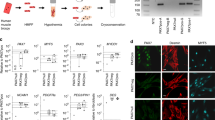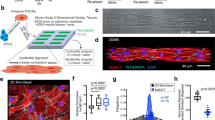Abstract
Relatively low levels of expression from naturally occurring promoters have limited the use of muscle as a gene therapy target. Myogenic restricted gene promoters display complex organization usually involving combinations of several myogenic regulatory elements. By random assembly of E-box, MEF-2, TEF-1, and SRE sites into synthetic promoter recombinant libraries, and screening of hundreds of individual clones for transcriptional activity in vitro and in vivo, several artificial promoters were isolated whose transcriptional potencies greatly exceed those of natural myogenic and viral gene promoters.
This is a preview of subscription content, access via your institution
Access options
Subscribe to this journal
Receive 12 print issues and online access
$209.00 per year
only $17.42 per issue
Buy this article
- Purchase on Springer Link
- Instant access to full article PDF
Prices may be subject to local taxes which are calculated during checkout




Similar content being viewed by others
References
Draghia-Akli, R., Li, X. & Schwartz, R.J. Enhanced growth by ectopic expression of growth hormone releasing hormone using an injectable myogenic vector. Nat. Biotechnol. 15, 1285–1289 ( 1997).
Haase, G. et al. Gene therapy of murine motor neuron disease using adenoviral vectors for neurotrophic factors. Nat. Med. 3, 429– 436 (1997).
Tripathy, S.K. et al. Long-term expression of erythropoietin in the systemic circulation of mice after intramuscular injection of a plasmid DNA vector. Proc. Natl. Acad. Sci. USA 93, 10876– 10880 (1996).
Wolff, J.A., Ludtke, J.J., Acsadi, G., Williams, P. & Jani, A. Long-term persistence of plasmid DNA and foreign gene expression in mouse muscle. Hum. Mol. Genet. 1, 363–369 (1992).
Acsadi, G. et al. Direct gene transfer and expression into rat heart in vivo. New Biologist. 3, 71–81 ( 1991).
Montgomery, D.L., Ulmer, J.B., Donnelly, J.J. & Liu, M.A. 1997. DNA Vaccines Pharmacol. Ther. 74, 195–205 (1991).
Lee, T.C., Shi, Y. & Schwartz, R.J. Displacement of BrdUrd-induced YY1 by serum response factor activates skeletal alpha-actin transcription in embryonic myoblasts. Proc. Natl. Acad. Sci. USA 89, 9814– 9818 (1992).
Bergsma, D.J., Grichnik, J.M., Gossett, L.M. & Schwartz, R.J. Delimitation and characterization of cis-acting DNA sequences required for the regulated expression and transcriptional control of the chicken skeletal alpha-actin gene. Mol. Cell. Biol. 6, 2462 –2475 (1986).
Chow, K.L. & Schwartz, R.J. A combination of closely associated positive and negative cis- acting promoter elements regulates transcription of the skeletal alpha-actin gene. Mol. Cell. Biol. 10, 528–538 (1990).
Minty, A. & Kedes, L. Upstream regions of the human cardiac actin gene that modulate its transcription in muscle cells: presence of an evolutionarily conserved repeated motif. Mol. Cell. Biol. 6, 2125–2136 (1986).
Gossett, L.A., Kelvin, D.J., Sternberg, E.A. & Olson, E.N. A new myocyte-specific enhancer-binding factor that recognizes a conserved element associated with multiple muscle-specific genes. Mol. Cell. Biol. 9, 5022–5033 ( 1989).
Olson, E.N. et al. Molecular control of myogenesis: antagonism between growth and differentiation. Mol. Cell. Biochem. 104, 7– 13 (1991).
Weintraub, H., Davis, R., Lockshon, D. & Lassar, A. MyoD binds cooperatively to two sites in a target enhancer sequence: occupancy of two sites is required for activation. Proc. Natl. Acad. Sci. USA 87, 5623–5627 (1990).
Lassar, A.B. et al. Functional activity of myogenic HLH proteins requires hetero-oligomerization with E12/E47-like proteins in vivo. Cell 66, 305–315 (1991).
Larkin, S.B., Farrance, I.K. & Ordahl, C.P. Flanking sequences modulate the cell specificity of M-CAT elements. Mol. Cell. Biol. 16, 3742 –3755 (1996).
Stewart, A.F. et al. Muscle-enriched TEF-1 isoforms bind M-CAT elements from muscle-specific promoters and differentially activate transcription. J. Biol. Chem. 269, 3147–3150 ( 1994).
Schwartz, R.J. & Rothblum, K.N. Gene switching in myogenesis: differential expression of the chicken actin multigene family. Biochemistry 20, 4122– 4129 (1981).
Lee, T.C., Zhang, Y. & Schwartz, R.J. Bifunctional transcriptional properties of YY1 in regulating muscle actin and c-myc gene expression during myogenesis. Oncogene. 9, 1047–1052 ( 1994).
Chow, K.L., Hogan, M.E. & Schwartz, R.J. Phased cis-acting promoter elements interact at short distances to direct avian skeletal alpha-actin gene transcription. Proc. Natl. Acad. Sci. USA 88, 1301– 1305 (1991).
Machon, O., Strmen, V., Hejnar, J., Geryk, J. & Svoboda, J. Sp1 binding sites inserted into the Rous sarcoma virus long terminal repeat enhance LTR-driven gene expression. Gene 208, 73–82 (1998).
Barnhart, K., Hartikka, J., Manthorpe, M., Norman, J. & Hobart P. Enhancer and promoter chimeras in plasmids designed for intramuscular injection: a comparative in vivo and in vitro study. Hum. Gene Ther. 9, 2545– 2553 (1998).
Hayward, L.J. & Schwartz, R.J. Sequential expression of chicken actin genes during myogenesis. J. Biol. Chem. 102, 1485–1493 (1986).
Hartikka, J. et al An improved plasmid DNA expression vector for direct injection into skeletal muscle. Hum. Gene Ther. 7, 1205 –1217 (1996).
Skarli, M., Kiri, A., Vrbova, G., Lee, C.A. & Goldspink, G. Myosin regulatory elements as vectors for gene transfer by intramuscular injection. Gene Ther. 5, 514–520 (1998).
Acknowledgements
We thank Leigh Anne Hill and Brandon Malone for excellent technical assistance and Craig Delaughter for carefully reviewing our manuscript. We acknowledge support for this study from Applied Veterinary Systems Inc. (Houston, Texas), GeneMedicine (The Woodlands, Texas), The Texas Advanced Technology Program, and the National Space Biological Research Institute (NASA).
Author information
Authors and Affiliations
Corresponding author
Rights and permissions
About this article
Cite this article
Li, X., Eastman, E., Schwartz, R. et al. Synthetic muscle promoters: activities exceeding naturally occurring regulatory sequences. Nat Biotechnol 17, 241–245 (1999). https://doi.org/10.1038/6981
Received:
Accepted:
Issue Date:
DOI: https://doi.org/10.1038/6981
This article is cited by
-
Therapeutic potential of highly functional codon-optimized microutrophin for muscle-specific expression
Scientific Reports (2022)
-
Engineered bacterial voltage-gated sodium channel platform for cardiac gene therapy
Nature Communications (2022)
-
Evaluation of the dystrophin carboxy-terminal domain for micro-dystrophin gene therapy in cardiac and skeletal muscles in the DMDmdx rat model
Gene Therapy (2022)
-
TRPC3, but not TRPC1, as a good therapeutic target for standalone or complementary treatment of DMD
Journal of Translational Medicine (2021)
-
Muscle overexpression of Klf15 via an AAV8-Spc5-12 construct does not provide benefits in spinal muscular atrophy mice
Gene Therapy (2020)



